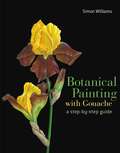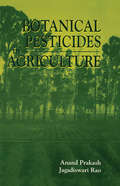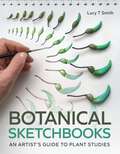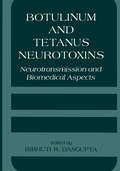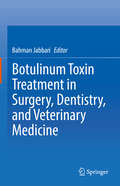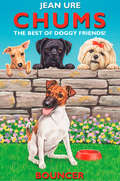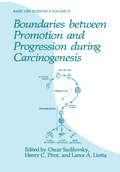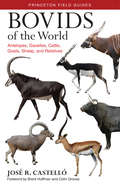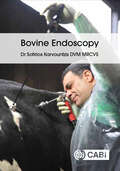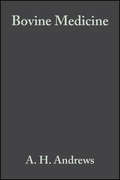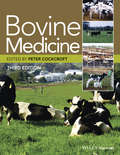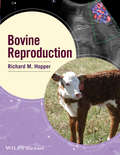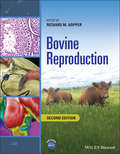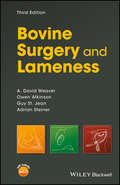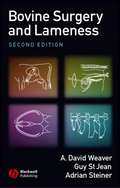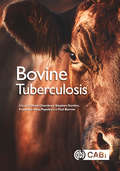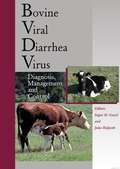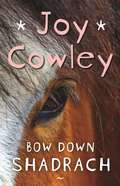- Table View
- List View
Botanical Pesticides in Agriculture
by Anand Prakash Jagadiswari RaoDue to the prohibitive cost of synthetic pesticides and the problems of environmental pollution caused by continuous use of these chemicals, there is a renewed interest in the use of botanicals for crop protection. Agricultural entomologists, nematologists, and pathologists the world over are now actively engaged in research into the use of plants to fight agricultural pests and diseases, and to reduce the losses caused by them. Botanical Pesticides in Agriculture reviews the research on botanical pesticides used to combat losses due to pests of agricultural importance, with special attention focused on the use of higher plants. This book will serve as the baseline reference work for future research, and many of the botanicals discussed, such as neem, bael, begonia, pyrethrum, tobacco, karanj, and mahuwa, may become integral parts of pest control programs currently being developed. It is believed that botanical pesticides will minimize the undesirable side effects of synthetic pesticides and help preserve the environment for future generations.
Botanical Pesticides in Agriculture
by Anand Prakash Jagadiswari RaoDue to the prohibitive cost of synthetic pesticides and the problems of environmental pollution caused by continuous use of these chemicals, there is a renewed interest in the use of botanicals for crop protection. Agricultural entomologists, nematologists, and pathologists the world over are now actively engaged in research into the use of plants to fight agricultural pests and diseases, and to reduce the losses caused by them. Botanical Pesticides in Agriculture reviews the research on botanical pesticides used to combat losses due to pests of agricultural importance, with special attention focused on the use of higher plants. This book will serve as the baseline reference work for future research, and many of the botanicals discussed, such as neem, bael, begonia, pyrethrum, tobacco, karanj, and mahuwa, may become integral parts of pest control programs currently being developed. It is believed that botanical pesticides will minimize the undesirable side effects of synthetic pesticides and help preserve the environment for future generations.
Botanical Sketchbooks: An Artist's Guide to Plant Studies
by Lucy SmithThis inspirational guide explains how a botanical sketchbook can take many forms and hold different meanings. It shows how a sketchbook can be used as a workbook to study plants through drawing and painting in a variety of media. It includes examples of preliminary work for finished pieces, experiments in colour and exploration of plant anatomy, and shows how these studies can be made away from the pressure of creating the perfect, polished piece of final botanical artwork. It goes on to feature sketchbooks created for their own sake as a curated space for an artist to draw and record plants over a period of time, or a particular place.
Botulinum and Tetanus Neurotoxins: Neurotransmission and Biomedical Aspects
by B. R. DasGuptaThree days in Madison have thoroughly modified my view on clostridial neurotoxins. While still realizing the numerous activating, modifying and protective inputs, I cannot judge the meaningfulness of the meeting impartially. Neither may the reader expect a complete summary of all presentations. Collected in this volume, they speak for themselves without requiring an arbiter. Instead I shall write down my very personal opinions as a researcher who has studied clostridial neurotoxins for nearly 25 years. Comparable conferences have been rare during this time. A comprehensive symposium 4 on C. botulinum neurotoxins has been organized at Ft. Detrick. International conferences on tetanus have been held regularly under the auspices of the Wodd Health Organization. One or maximally two days of these meetings have been devoted to tetanus toxin and its actions whereas the sponsor and the majority of the participants have been interested mainly in epidemiology, prevention and treatment of tetanus as a disease (see refs. 5,6). Some aspects of clostridial neurotoxins have been addressed in the context of bacterial toxins, in particular in the biennial European workshops. 1-3,7,8 The Madison meeting differed from the previous ones in three aspects. First, it covered both tetanus and botulinum neurotoxins. The fusion was justified because of their huge similarities in primary structure, in their mode of action and in their cellular targets. Second, the meeting was not limited to toxins but drew some lines on which modern neurobiology might proceed.
Botulinum Toxin Treatment in Surgery, Dentistry, and Veterinary Medicine
by Bahman JabbariAll books on the market which have been written on the subject of botulinum toxin therapy focus on treatment of hyperactive movement disorders, autonomic dysfunction (bladder, sweat and salivary glands) and some pain indications (migraine). Reference to pre-or post -surgical indications are brief and often out-dated. No book has information on dentistry or veterinary medicine. This book provides up-to-date information on botulinum toxin therapy in surgical fields. It is also the only book in the market that provides information on botulinum toxin therapy in dentistry and veterinary medicine, furnishing the latest information. Botulinum Toxin Treatment in Surgery, Dentistry, and Veterinary Medicine appeals to many disciplines including surgery, dentistry and veterinary medicines well as appealing to neurologists and internists.
Bouncer (Chums #No. 3)
by Jean UreFour stray dogs, all with a story to tell of their rescue and how they came to live at Munchy Flats Cottage, with their people Flossie and Joe.
Boundaries between Promotion and Progression during Carcinogenesis (Basic Life Sciences #57)
by Oscar Sudilovsky Henry C. Pitot L. A. LiottaThe pUrpOSE! of this conference was not to define the two areas that are being bound, which might be a well nigh impossible proposition. Rather, its focus was to concentrate on the mechanistic similarities between promotion and progression. Are the areas involved within the boundaries a continuum? Are these two simultaneous processes? Or are some of the affected cells in the stage of promotion when at the same time others have undergone irreversi ble changes tha. t position them in the stage of progression? Or are these two stages the same thing, but called by different names? To explore such concepts we assembled investigators with various back grounds and asked them to specifically address these and other questions about "The Boundaries", within the context of the session to which they con tributed. The conference lasted two and a half days, from Wednesday to Friday. There were at least four speakers per session with morning and after noon sessions each day, except on Friday when the meeting ended at noon. The first day, each speaker had 25 minutes to present a position, followed by five minutes of discussion. At the end of the session there were 40 or 50 minutes of exchange on all the issues examined. For the remaining days, there were 25 minutes of presentation and 15 minutes of discussion.
Bovids of the World: Antelopes, Gazelles, Cattle, Goats, Sheep, and Relatives
by José R. Castelló Brent Huffman Colin GrovesBovids are a diverse group of ruminant mammals that have hooves and unbranched hollow horns. Bovids of the World is the first comprehensive field guide to cover all 279 bovid species, including antelopes, gazelles, cattle, buffaloes, sheep, and goats. From the hartebeest of Africa and the takin of Asia to the muskox of North America, bovids are among the world's most spectacular animals and this stunningly illustrated and easy-to-use field guide is an ideal way to learn more about them.The guide covers all species and subspecies of bovids described to date. It features more than 300 superb full-color plates depicting every kind of bovid, as well as detailed facing-page species accounts that describe key identification features, horn morphology, distribution, subspeciation, habitat, and conservation status in the wild. This book also shows where to observe each species and includes helpful distribution maps.Suitable for anyone with an interest in natural history, Bovids of the World is a remarkable and attractive reference, showcasing the range and beauty of these important mammals.The first comprehensive field guide to all 279 bovid species337 full-color plates, with more than 1,500 photographs Detailed species accounts describe key identification features, distribution, subspeciation, habitat, behavior, reproduction, and conservation statusFully updated and revised taxonomy, with common and scientific namesEasy-to-read distribution maps
Bovids of the World: Antelopes, Gazelles, Cattle, Goats, Sheep, and Relatives (PDF)
by José R. Castelló Brent Huffman Colin GrovesBovids are a diverse group of ruminant mammals that have hooves and unbranched hollow horns. Bovids of the World is the first comprehensive field guide to cover all 279 bovid species, including antelopes, gazelles, cattle, buffaloes, sheep, and goats. From the hartebeest of Africa and the takin of Asia to the muskox of North America, bovids are among the world's most spectacular animals and this stunningly illustrated and easy-to-use field guide is an ideal way to learn more about them.The guide covers all species and subspecies of bovids described to date. It features more than 300 superb full-color plates depicting every kind of bovid, as well as detailed facing-page species accounts that describe key identification features, horn morphology, distribution, subspeciation, habitat, and conservation status in the wild. This book also shows where to observe each species and includes helpful distribution maps.Suitable for anyone with an interest in natural history, Bovids of the World is a remarkable and attractive reference, showcasing the range and beauty of these important mammals.The first comprehensive field guide to all 279 bovid species337 full-color plates, with more than 1,500 photographs Detailed species accounts describe key identification features, distribution, subspeciation, habitat, behavior, reproduction, and conservation statusFully updated and revised taxonomy, with common and scientific namesEasy-to-read distribution maps
Bovine Endoscopy
by Dr Sotirios KarvountzisEndoscopic applications are recognised and well-established techniques in human surgery, where a variety of procedures are performed routinely. A less intrusive and labour demanding process than surgery, these procedures have great potential for use in veterinary medicine. They allow a quicker clinical recovery, minimal intrusion and risk of bacterial exposure, and a lower mortality than conventional surgical options. Beginning with an introduction to the topic and an overview of bovine anatomy, this book then discusses both mainstream and experimental applications of endoscopy in cattle. It covers: - Practical advice on preparing for the procedure and patient restraint; - Techniques including LDA corrections, RDA corrections, exploratory laparoscopy, exploratory thoracoscopy, theloscopy and umbilical hernia corrections; - Post-operative care to allow the animal to rejoin the herd at the next milking, whenever possible. Written in a practical and accessible style for veterinary practitioners and students, the book provides a thorough and complete introduction to the exciting new field of bovine endoscopy.
Bovine Medicine: Diseases and Husbandry of Cattle
by Anthony H. Andrews Roger W. Blowey Hugh Boyd Roger G. EddyBovine Medicine provides practical and comprehensive information on cattle disease and production and is a key reference for all large animal vets. Since the first edition was published in 1991 there have been significant improvements in disease control and management of cattle. Almost all parts of the book have been updated and completely rewritten. There are new chapters on surgery, embryo transfer, artificial insemination, ethno-veterinary medicine and biosecurity, and a new consolidating chapter on the interaction between the animal, environment, management and disease. The previous edition has sold all over the world, and as a result of this a greater emphasis has been placed on conditions and their treatment in areas other than temperate regions. A new section entitled "Global Variation in Cattle Practice" has been included with contributors discussing bovine medicine practice in their part of the world. All in all this is an outstanding resource for any practising vet and an excellent reference for veterinary students.
Bovine Medicine
by Peter CockcroftThoroughly updated to reflect recent changes in the industry, Bovine Medicine, 3rd Edition, offers practicing large animal veterinarians and veterinary students a comprehensive reference to core aspects of contemporary cattle health and husbandry. New edition of a classic text, featuring thoroughly rewritten text, with coverage shifted to the core aspects of everyday cattle practice Includes new focus on both applied skills and application of knowledge, along with many more full-colour illustrations than in previous editions Represents a toolkit of skills that will support the delivery of contemporary cattle practice Presents a seamless integration of information on husbandry, nutrition, and disease Written by a wide range of experts from around the world
Bovine Medicine
by Peter D. CockcroftThoroughly updated to reflect recent changes in the industry, Bovine Medicine, 3rd Edition, offers practicing large animal veterinarians and veterinary students a comprehensive reference to core aspects of contemporary cattle health and husbandry. New edition of a classic text, featuring thoroughly rewritten text, with coverage shifted to the core aspects of everyday cattle practice Includes new focus on both applied skills and application of knowledge, along with many more full-colour illustrations than in previous editions Represents a toolkit of skills that will support the delivery of contemporary cattle practice Presents a seamless integration of information on husbandry, nutrition, and disease Written by a wide range of experts from around the world
Bovine Reproduction
by Richard M. HopperBovine Reproduction is a comprehensive, current reference providing information on all aspects of reproduction in the bull and cow. Offering fundamental knowledge on evaluating and restoring fertility in the bovine patient, the book also places information in the context of herd health where appropriate for a truly global view of bovine theriogenology. Printed in full color throughout, the book includes 83 chapters and more than 550 images, making it the most exhaustive reference available on this topic. Each section covers anatomy and physiology, breeding management, and reproductive surgery, as well as obstetrics and pregnancy wastage in the cow. Bovine Reproduction is a welcome resource for bovine practitioners, theriogenologists, and animal scientists, as well as veterinary students and residents with an interest in the cow.
Bovine Reproduction
by Richard M. HopperBovine Reproduction is a comprehensive, current reference providing information on all aspects of reproduction in the bull and cow. Offering fundamental knowledge on evaluating and restoring fertility in the bovine patient, the book also places information in the context of herd health where appropriate for a truly global view of bovine theriogenology. Printed in full color throughout, the book includes 83 chapters and more than 550 images, making it the most exhaustive reference available on this topic. Each section covers anatomy and physiology, breeding management, and reproductive surgery, as well as obstetrics and pregnancy wastage in the cow. Bovine Reproduction is a welcome resource for bovine practitioners, theriogenologists, and animal scientists, as well as veterinary students and residents with an interest in the cow.
Bovine Reproduction
by Richard M. HopperBovine Reproduction A complete resource for practical, authoritative information on all aspects of bovine theriogenologyThe newly revised Second Edition of Bovine Reproduction delivers a comprehensive overview of all major issues in bovine reproduction. Written by leading experts in the subject, the book is an indispensable reference for any veterinarian dealing with bovine fertility. Bovine Reproduction is divided into sections on the bull, the cow, the neonate, and assisted reproduction techniques. New chapters cover new gene manipulation technologies, managing problem donors, lameness, and more. Outdated and redundant information from the First Edition has been removed and replaced by coverage of new diseases, technologies, procedures, techniques, and approaches to fertility problems. A new companion website provides images and tables from the book in PowerPoint format. In addition to more than 675 full-color images, readers will also benefit from: A thorough discussion of the anatomy and physiology of the bull, including the endocrine and exocrine function of bovine testes and the thermoregulation of the testes An exploration of breeding and health management of bulls, including the evaluation of breeding soundness and ultrasound examination of the reproductive tract An examination of the anatomy, physiology, and the breeding and health management of cows, including fetal programming, the reproductive tract microbiome, and a section on obstetrics and reproductive surgery A review of the management of both critical care of the neonate and effective colostrum assessment and provision An introduction to assisted and advanced reproductive technologies A practical and comprehensive reference, Bovine Reproduction is a must-have purchase for bovine practitioners, theriogenologists, animal scientists, veterinary students, and residents with an interest in cattle.
Bovine Reproduction
by Richard M. HopperBovine Reproduction A complete resource for practical, authoritative information on all aspects of bovine theriogenologyThe newly revised Second Edition of Bovine Reproduction delivers a comprehensive overview of all major issues in bovine reproduction. Written by leading experts in the subject, the book is an indispensable reference for any veterinarian dealing with bovine fertility. Bovine Reproduction is divided into sections on the bull, the cow, the neonate, and assisted reproduction techniques. New chapters cover new gene manipulation technologies, managing problem donors, lameness, and more. Outdated and redundant information from the First Edition has been removed and replaced by coverage of new diseases, technologies, procedures, techniques, and approaches to fertility problems. A new companion website provides images and tables from the book in PowerPoint format. In addition to more than 675 full-color images, readers will also benefit from: A thorough discussion of the anatomy and physiology of the bull, including the endocrine and exocrine function of bovine testes and the thermoregulation of the testes An exploration of breeding and health management of bulls, including the evaluation of breeding soundness and ultrasound examination of the reproductive tract An examination of the anatomy, physiology, and the breeding and health management of cows, including fetal programming, the reproductive tract microbiome, and a section on obstetrics and reproductive surgery A review of the management of both critical care of the neonate and effective colostrum assessment and provision An introduction to assisted and advanced reproductive technologies A practical and comprehensive reference, Bovine Reproduction is a must-have purchase for bovine practitioners, theriogenologists, animal scientists, veterinary students, and residents with an interest in cattle.
Bovine Surgery and Lameness (Library Of Veterinary Practice Ser.)
by A. David Weaver Owen Atkinson Guy St. Jean Adrian SteinerThe revised and updated Third Edition of Bovine Surgery and Lameness offers veterinarians a concise text ideal for use in the field. Offers a fully revised edition of the popular and well-respected book on bovine surgery and lameness Presents a practical quick-reference guide ideal for the field veterinarian Covers both common surgical procedures and the latest information on combating lameness Written by an expert team of international authors Includes access to a companion website offering video clips
Bovine Surgery and Lameness
by A. David Weaver Owen Atkinson Guy St. Jean Adrian SteinerThe revised and updated Third Edition of Bovine Surgery and Lameness offers veterinarians a concise text ideal for use in the field. Offers a fully revised edition of the popular and well-respected book on bovine surgery and lameness Presents a practical quick-reference guide ideal for the field veterinarian Covers both common surgical procedures and the latest information on combating lameness Written by an expert team of international authors Includes access to a companion website offering video clips
Bovine Surgery and Lameness (Library of Veterinary Practice)
by A. David Weaver Guy St. Jean Adrian SteinerBovine surgery is both challenging and complicated. Not only does the surgeon have to decide whether surgery is economically justified, but surgery often has to be performed in a sub-optimal environment. Following on from the worldwide success of the first edition, this new edition continues to act as a step-by-step guide to standard surgical techniques. Now with two new authors from Switzerland and North America, both the text and illustrations have been considerably expanded. In addition, special attention is given to issues relating to peri-operative analgesia and animal welfare, food safety, and drug dosages. Maintains the popular concise and accessible format of the first edition – perfect for on-the-field work; Two additional authors, with world renowned expertise in bovine surgery and lameness; Detailed instruction on the basics of effective surgery – proper instrumentation, asepsis, effective anaesthesia and essential techniques; Much more information on lameness, as well as numerous new line drawings to aid instruction.
Bovine Surgery and Lameness
by A. David Weaver Guy St. Jean Adrian SteinerBovine surgery is both challenging and complicated. Not only does the surgeon have to decide whether surgery is economically justified, but surgery often has to be performed in a sub-optimal environment. Following on from the worldwide success of the first edition, this new edition continues to act as a step-by-step guide to standard surgical techniques. Now with two new authors from Switzerland and North America, both the text and illustrations have been considerably expanded. In addition, special attention is given to issues relating to peri-operative analgesia and animal welfare, food safety, and drug dosages. Maintains the popular concise and accessible format of the first edition – perfect for on-the-field work; Two additional authors, with world renowned expertise in bovine surgery and lameness; Detailed instruction on the basics of effective surgery – proper instrumentation, asepsis, effective anaesthesia and essential techniques; Much more information on lameness, as well as numerous new line drawings to aid instruction.
Bovine Tuberculosis
by A. Arunachalam H. A. Bahamonde L. Borrelli S. Briggs G. Caballé C. Carrasco S. X. Chang C. Concha S. K. Dhyani F. Dube C. Dupraz M. E. Fernández C. Figueroa V. Gargaglione H. E. Garrett M. A. Gold Professor Andrew Gordon J. Gyenge N. E. Hansen M. F. Hawke S. Jose P. D. Kemp R. L. Knowles B. M. Kumar N. Lamersdorf G. J. Lawson M. V. Lencinas C. E. Lloyd G. Martínez Pastur R. Moore B. Müller-Using P. Neira S. Ormaechea V. P. Papanastasis X. Peng P. L. Peri D. J. Pilbeam A. Rosati J. Ruiz-Mirazo V. Rusch M. Sarasola J. M. Schwenke V. Schwenke R. Soler N. B. Stolpe L. E. Tejera N. V. Thevathasan A.R. von Müller W. Wang T. Ward L. Zabek E. ZagalThis book is contemporary, topical and global in its approach, and provides an essential, comprehensive treatise on bovine tuberculosis and the bacterium that causes it, Mycobacterium bovis. Bovine tuberculosis remains a major cause of economic loss in cattle industries worldwide, exacerbated in some countries by the presence of a substantial wildlife reservoir. It is a major zoonosis, causing human infection through consumption of unpasteurised milk or by close contact with infected animals. Following a systematic approach, expert international authors cover epidemiology and the global situation; microbial virulence and pathogenesis; host responses to the pathogen; and diagnosis and control of the disease. Aimed at researchers and practising veterinarians, this book is essential for those needing comprehensive information on the pathogen and disease, and offers a summary of key information learned from human tuberculosis research. It will be useful to those studying the infection and for those responsible for controlling the disease.
Bovine Viral Diarrhea Virus: Diagnosis, Management,and Control
by Sagar M. Goyal Julia F. RidpathFor almost 60 years, continual research on the subject of Bovine Viral Diarrhea (BVD) has raised as many questions as that research has answered. This common disease continues to cause sickness, death, abortion and fetal anomalies despite the millions of vaccination doses used each year to prevent its spread. Written by international experts on the subject of the BVD virus, BVDV: Diagnosis, Management and Control includes the latest information on BVD and outlines methods of diagnosis, management and control. Researchers, academics, and large animal practitioners will find this book an invaluable and irreplaceable resource for understanding and controlling outbreaks of BVD.
Bow Down Shadrach
by Joy Cowley** Winner of the New Zealand Children's Book of the Year 1990** A classic junior fiction favourite from multi-award winning New Zealand children's author, Joy Cowley.Shadrach is a very old circus-trained Clydesdale horse, and the favourite family pet. When Hannah discovers that Shadrach has been sold to a dog food factory, she decides to mount a heroic rescue and enlists the help of her two younger brothers. From the beginning their plans go seriously wrong. By the time they've argued with the repulsive Wuff Stuff man, hidden Shadrach in a church and a caravan, and floated him on a mussel barge they're in desperate need of rescuing themselves.
